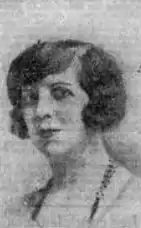Ève Paul-Margueritte Gaucher | |
|---|---|
 1936 | |
| Born | Ève Antonie Paul-Margueritte 5 February 1885 6th arrondissement of Paris, France |
| Died | 16 July 1971 Limeil-Brévannes, Paris, France |
| Occupation |
|
| Language | French |
| Nationality | French |
| Notable works | Auteuil et Passy |
| Notable awards |
|
| Spouse |
Charles Gaucher
(m. 1919; died 1927) |
| Parents | Paul Margueritte |
| Relatives |
|
Ève Paul-Margueritte (5 February 1885 – 16 July 1971) was a French-language writer, the author of many sentimental novels. After she was widowed and her sister, Lucie Paul-Margueritte, was divorced, they lived and worked together, co-authoring at least two books, and several translations. She translated from English to French works by Alice and Claude Askew, Thomas Hardy, E. Phillips Oppenheim, Garrett P. Serviss, Bram Stoker Lilian Turner, Paul Urquhart, and A. M. Williamson. Paul-Margueritte was the recipient of the "Prix Jean-Jacques-Berger", for Auteuil et Passy, 1947, and the "Prix Georges-Dupau", 1950, from the Académie Française.
Biography
Ève Antonie Paul-Margueritte[1] was born 5 February 1885, in the 6th arrondissement of Paris.[2] She was the daughter of Paul Margueritte, the niece of Victor Margueritte, and the granddaughter of Jean Auguste Margueritte.
In 1919, she married Charles Gaucher (1877-1927).[1][3][4] After Ève was widowed and Lucie divorced, the sisters lived together, raising the former's son and living off their writings.[5]
With Lucie, Paul-Margueritte translated many English-language novels, including Bram Stoker's Dracula[6] and others by Thomas Hardy and Alice Muriel Williamson.
Both of the sisters were members of the first women's gastronomic club, the "Club des belles perdrix".[7]
Ève Paul-Margueritte died in Limeil-Brévannes, 16 July 1971,[2] and is buried, along with her sister, in the Cimetière d'Auteuil.[8]
Awards and honours
- 1947, Prix Jean-Jacques-Berger, for Auteuil et Passy[9]
- 1950, Prix Georges-Dupau from the Académie Française[10]
Selected works
Books

- La Folle Poursuite (1922)
- La Rencontre de minuit (1926)
- Les Sainte-Catherine (1927)
- Le Sortilège (1928)
- La Fiancée captive (1929)
- La Souricière (1929)
- Circé ou l'Envers de la tapisserie (1937)
- Auteuil et Passy (1947; with Lucie Paul-Margueritte)
- Le Chalet rouge (1955)
- Deux frères, deux sœurs, deux époques littéraires (1951; with Lucie Paul-Margueritte)
Short stories
- "La Prison blanche" (1917), in Collection Stella, no. 172; first appeared in L'Écho de Paris (1915)
- "L'Énigmatique Marielle" (1933), in Les Beaux Romans dramatiques, no. 67
- "Coup double" (1941), in Collection Stella, no. 516
- "Le Secret d'une vendetta" (1941), in Collection Stella, no. 502
Translations
- Rip, l'homme qui dormit vingt ans et autres contes d'Amérique
- La Bien-aimée (1909); from The Well-beloved, by Thomas Hardy
- Anna l'aventureuse (1909), from a story by E. Phillips Oppenheim
- L'Ombre (1909), from a story by Paul Urquhart
- Le Second Déluge, (1912, with Lucie Paul-Margueritte); from The Second Deluge, by Garrett P. Serviss
- La Belle aux cheveux d'or (1912, with Lucie Paul-Margueritte); from a story by Alice and Claude Askew
- Sept belles pécheresses: Duchesse de Chateauroux, Duchesse de Kendal, Catherine II de Russie, Duchesse de Kingston, Comtesse de Lamotte, Duchesse de Polignac, Lola Montes (1913, with Lucie Paul-Margueritte); from Seven splendid sinners, by W. R. H. ( (William Rutherford Hayes)) Trowbridge
- Thyrza (1913); from George Gissing
- Deux yeux bleus (1913); from A pair of blue eye, by Thomas Hardy
- L'Araignée noire (1914); from a story by Frank Barrett
- Vers les étoiles (1914, with Lucie Paul-Margueritte); from Stairways to the Stars by Lilian Turner
- Le Chevalier de la rose blanche (1918, with Lucie Paul-Margueritte); from a story by Alice Muriel Williamson
- L'enveloppe aux cachets d'or (1919; from a story by Alice Muriel Williamson
- L'homme de la nuit (1920, with Lucie Paul-Margueritte); from Dracula, by Bram Stoker
References
- 1 2 "Charles Joseph GAUCHER, 1877 - 1927". www.myheritage.com. Retrieved 17 January 2022.
- 1 2 "Acte de naissance (no. 354)" (in French). Archives de Paris (6e). 1885. Retrieved 17 January 2022.
- ↑ Paul-Margueritte, Ève (1951). Deux frères, deux soeurs: deux époques littéraires (in French). J. Peyronnet. p. 174. Retrieved 17 January 2022.
- ↑ "Le Figaro". 31 July 1919. Retrieved 17 January 2022 – via Gallica.
- ↑ Mamelouk, Nadia Nadja (2008). Anxiety in the Border Zone: Transgressing Boundaries in Leïla: Revue Illustrée de la Femme (Tunis, 1936-1940) and in Leïla: Hebdomadaire Tunisien Indépendant (Tunis, 1940-1941). University of Virginia. Retrieved 16 January 2022.
- ↑ Stoker, Bram; Paul-Margueritte, E. (1920). Dracula: l'homme de la nuit (in French). Edition française.
- ↑ Les recettes des "Belles Perdrix" / recueillies par Gabrielle Reval et Maria Croci (in French). 1930. p. 42. Retrieved 16 January 2022 – via Gallica.
- ↑ "cimetière d'AUTEUIL". www.landrucimetieres.fr. Cimetières de France et d'ailleurs. 21 July 2008. Retrieved 17 January 2022.
- ↑ "Rapport sur les concours littéraires de l'année 1947". francaise.fr (in French). Académie française.
- ↑ "Rapport sur les concours littéraires de l'année 1950 /". francaise.fr (in French). Académie française.